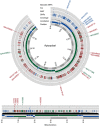A barcode of organellar genome polymorphisms identifies the geographic origin of Plasmodium falciparum strains
- PMID: 24923250
- PMCID: PMC4082634
- DOI: 10.1038/ncomms5052
A barcode of organellar genome polymorphisms identifies the geographic origin of Plasmodium falciparum strains
Abstract
Malaria is a major public health problem that is actively being addressed in a global eradication campaign. Increased population mobility through international air travel has elevated the risk of re-introducing parasites to elimination areas and dispersing drug-resistant parasites to new regions. A simple genetic marker that quickly and accurately identifies the geographic origin of infections would be a valuable public health tool for locating the source of imported outbreaks. Here we analyse the mitochondrion and apicoplast genomes of 711 Plasmodium falciparum isolates from 14 countries, and find evidence that they are non-recombining and co-inherited. The high degree of linkage produces a panel of relatively few single-nucleotide polymorphisms (SNPs) that is geographically informative. We design a 23-SNP barcode that is highly predictive (~92%) and easily adapted to aid case management in the field and survey parasite migration worldwide.
Figures


Comment in
-
Tracing the geographic origins of Plasmodium falciparum malaria parasites.Pathog Glob Health. 2014 Sep;108(6):261-2. doi: 10.1179/2047772414Z.000000000225. Pathog Glob Health. 2014. PMID: 25351581 Free PMC article. No abstract available.
References
-
- WHO. World Malaria Report 2012, WHO (available at http://www.who.int/ malaria/publications/world_malaria_report_2012/report/en/index.html) (2012).
-
- Luo H. M. et al.. Identification and control of a poliomyelitis outbreak in Xinjiang, China. N. Engl. J. Med. 369, 1981–1990 (2013). - PubMed
Publication types
MeSH terms
Grants and funding
LinkOut - more resources
Full Text Sources
Other Literature Sources

